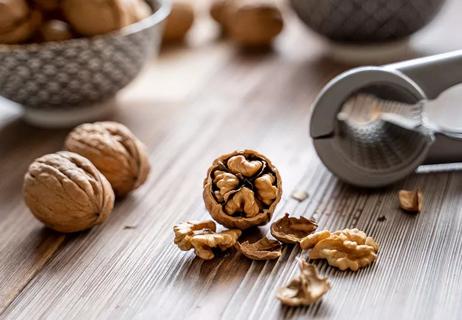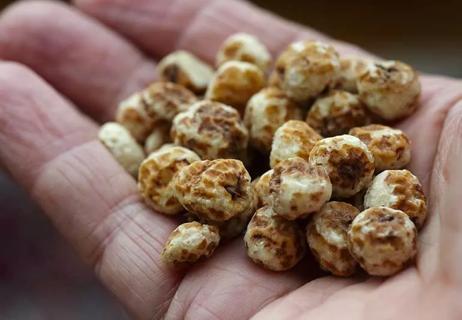Fill your nutrient gaps with smart nut picks

Long ago, our ancestors gathered nuts as a means of survival, and nuts have remained a staple in our diets ever since.
Advertisement
Cleveland Clinic is a non-profit academic medical center. Advertising on our site helps support our mission. We do not endorse non-Cleveland Clinic products or services. Policy
You’ll find them on appetizer trays, at sporting events, tossed in salads, stir-fried with vegetables and topped on sundaes. They’re ground up and used as spreads. They’re baked in our favorite cookies, pies and pastries. You get the point — nuts play a big part in our lives.
But should they?
You may have heard mixed reviews on the health content of nuts. You may have heard people say they’re high in fat. Or that because of the risk of nut allergies, they should be avoided.
The latest scientific evidence says otherwise.
Nuts are an important part of a heart-healthy diet. But research shows that only about one-third of Americans are eating them. Eating an assortment of nuts can have some serious health benefits. And feeding young babies peanut butter can actually help to protect them from peanut allergies.
We talked with registered dietitian Devon Peart, RD, MHSc, BASc, about the health benefits of various kinds of nuts and how you can get more of them in your diet.
Peart points to two large epidemiological studies that have shown some serious health benefits of eating more nuts: the Nurses’ Health Study and the Adventist Health Study. They assessed the diets of more than 110,000 people and found those who ate 5 or more ounces of nuts per week had a substantially lower risk of heart disease and death.
Advertisement
How much lower? People who ate more nuts lowered their risk by 35% to 50%. (Wow!)
Nuts come from many different plant families. They’re classified as either tree nuts (a one-seeded fruit in a hard shell) or peanuts (a member of the legume family). All of them share some similar health benefits. Among their benefits, nuts are:
A 1-ounce serving of nuts contains between 160 and 200 calories, of which 80% to 90% is composed of fat. So, yes, nuts are high in fat. But that’s not a reason to write them off.
The fat in nuts is primarily monounsaturated fat. When substituted for saturated fat in your diet, monounsaturated fat can help reduce your total cholesterol. They can also lower your LDL, or “bad” cholesterol levels, while maintaining your “good” cholesterol, HDL.
“Because nuts are high in fat, they are also relatively high in calories, so it’s important to incorporate them into your diet sensibly,” Peart clarifies. “Substitute nuts for food sources high in less-healthy fat, specifically saturated fat. For example, top your salad with nuts instead of bacon bits and croutons.”
And stick to a serving. All it takes is one, 1-ounce serving a day or 5 ounces per week of a variety of nuts to reap their heart disease-fighting benefits. How much is a serving?
“One serving of nuts is equal to one ounce,” Peart says. “About a handful.”
| Type of nut | How many in one serving size (1 oz.) |
|---|---|
| Peanuts | 35 |
| Almonds | 24 |
| Medium-sized cashews | 18 |
| Pecan halves | 15 |
| English walnut halves | 14 |
| Hazelnuts (also called filberts) | 12 |
| Macadamia nuts | 12 |
| Medium-sized Brazil nuts | 8 |
| Type of nut | |
| Peanuts | |
| How many in one serving size (1 oz.) | |
| 35 | |
| Almonds | |
| How many in one serving size (1 oz.) | |
| 24 | |
| Medium-sized cashews | |
| How many in one serving size (1 oz.) | |
| 18 | |
| Pecan halves | |
| How many in one serving size (1 oz.) | |
| 15 | |
| English walnut halves | |
| How many in one serving size (1 oz.) | |
| 14 | |
| Hazelnuts (also called filberts) | |
| How many in one serving size (1 oz.) | |
| 12 | |
| Macadamia nuts | |
| How many in one serving size (1 oz.) | |
| 12 | |
| Medium-sized Brazil nuts | |
| How many in one serving size (1 oz.) | |
| 8 |
All nuts offer health benefits, including plant protein and fiber, but they differ in terms of specific micronutrients.
“Micronutrients are widely distributed in foods,” Peart says. “So choose a variety of nuts, not always the same ones, in order to get a wide range of nutrients.”
Check out some of the benefits of these favorite nuts.
The U.S. Department of Agriculture (USDA) says peanuts contain more protein than any other Food and Drug Administration (FDA)-classified nut. They’re chock full of niacin, fiber and magnesium, too. Some manufactured peanuts — particularly the ones you find in the snack aisle — can come salted and oil-roasted, which aren’t as healthy. Head to the baking aisle instead to choose peanuts that are unsalted, dry-roasted and/or unprocessed.
Peanut butter contains the same heart-protective benefits as whole peanuts, but you’ll want to consider the source when choosing peanut butter.
“Manufacturers may add salt, sugar and sometimes, partially hydrogenated fats to peanut butter to enhance the flavor and make it spread more easily,” Peart explains. “Your best choice is natural peanut butter, which is just ground-up nuts.”
Advertisement
As the fat tends to separate on the store shelf, Peart recommends giving natural peanut butter a quick stir when you get it home, and then store it upside down in the fridge. And, as with nuts, peanut butter should be enjoyed in moderation — a serving is 2 tablespoons.
Peanuts make a great topping for healthy snacks, like on nonfat frozen yogurt and spread on celery sticks. You can also use peanut butter for this versatile spicy peanut sauce, which is perfect for grilled chicken, potstickers, spring rolls or sautéed vegetables.
Walnuts are an excellent source of polyunsaturated fat (a healthy fat). They’re also rich in omega-3 fatty acids. Omega-3 fatty acids effectively help reduce triglycerides (a type of fat in your blood) and are linked to a reduced risk of heart disease. One serving of walnuts also contains 2.5 grams of a powerful antioxidant called alpha-lipoic acid.
Walnuts are a great addition to a spinach salad and can be easily added to a variety of baked goods and side dishes, like these walnut zucchini potato pancakes.
Almonds are a source of calcium. One ounce of almonds contains around 80 milligrams of calcium, about 8% of your daily recommended amount. Calcium is known for its role in building strong bones and teeth, but it also helps to regulate your heartbeat.
Advertisement
Almonds are also a source of protein, with 6 grams per ounce — about the same as one egg.
Bring more almonds into your diet by adding them to yogurt as a crunchy treat. Or chop them up and add them to your banana bread or zucchini bread recipe. You can also use almond butter to add some nutty protein to your favorite smoothie, but keep in mind that almond milk isn’t a significant source of protein.
The USDA says that cashews are an excellent source of copper and magnesium. They also have high levels of manganese, phosphorus, zinc and vitamins B6 and K.
Cashews make a great addition to your favorite stir-fry recipe. Or grind them in a food processor to use as an ingredient for vegan ricotta “cheese” (a nondairy cheese alternative) for this roasted vegetable lasagna.
Pecans are high in manganese, an essential mineral in bone health, metabolism, heart functioning and more. A serving of pecans can get you almost 60% of your daily recommended amount of manganese. They’re also a rich source of the antioxidant vitamin E.
Pecans can be used in place of bread crumbs as a coating for salmon or chicken and are a popular addition to baked goods, like banana bread. You can also chop them up and pair them with oatmeal for delicious and healthy pancakes and waffles.
Advertisement
Like almonds, pistachios are a source of protein, with 6 grams per ounce. They’re also high in antioxidants, particularly lutein and zeaxanthin, which give them their green color.
Try mixing nonfat vanilla pudding with minced or chopped pistachios. Or try this quinoa, orange and pistachio salad.
Brazil nuts are an excellent source of selenium, a powerful antioxidant that supports healthy thyroid function and helps reduce inflammation. Selenium is important but we only need a small amount.
Have three Brazil nuts a day to meet your needs for selenium, as long as you’re not taking a selenium supplement.
“Never have more than five Brazil nuts in a day. And if you include Brazil nuts in your diet, you should not take a selenium supplement,” Peart stresses.
If you buy pre-mixed trail mixes for a quick treat, Peart suggests avoiding the ones with added salt or candied, dried fruit (like cranberries that have added sugar). You’re also better off skipping the ones that are cooked in tropical oils.
Or make your own custom trail mix. Peart suggests snack-sized baggies of nuts, whole-wheat Chex®, pretzel pieces, raisins, dates or other unsweetened dried fruits. You can add a few dark chocolate chips for some healthy sweetness, too.
However you enjoy them, Peart says to remember that adding nuts to your diet is just one of many nutritional strategies aimed at reducing your risk of heart disease.
“The best way to improve your heart health is a high-fiber diet, rich in complex carbohydrates (whole grains, legumes, nuts and seeds),” Peart says. “Add to that a variety of fruits, vegetables and calcium-rich dairy each day for optimal heart-health benefits. A heart-healthy diet coupled with regular physical activity effectively reduces your risk of coronary heart disease.”
Learn more about our editorial process.
Advertisement

Their antioxidants and healthy fats can help lower the risk of chronic diseases, build bones and prevent weight gain

This legume can reduce cholesterol and help with weight loss and healthy blood sugar levels

Packed with protein and potassium, this green-tinged nut can help with gut health and cholesterol levels

Packed with healthy fats and antioxidants, walnuts can help with heart, brain and gut health

These nuts are packed with healthy monounsaturated fat, protein and calcium

They’re not really nuts, but they ARE good for you, helping with digestion and blood sugar

What you need to know about the hidden risks

It's a simple protein, but you still need it in moderation.

Start having sex about 72 hours before ovulation, then at least every other day during your fertile window

Attachment theory suggests that your earliest relationships shape connections throughout your life

It isn’t a recognized mental health disorder, but research shows that problematic social media use can negatively affect your mental health, self-esteem and sleep